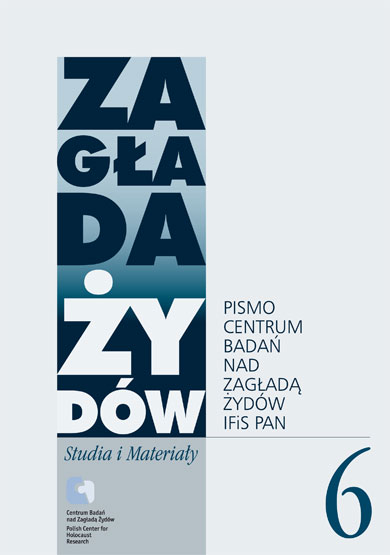Kicz w kinie holokaustowym
Zagłada Żydów. Studia i Materiały, Nr 6 (2010), Strony: 55-73
Data zgłoszenia: 2020-12-06Data publikacji: 2010-12-30
 https://doi.org/10.32927/zzsim.706
https://doi.org/10.32927/zzsim.706
Abstrakt
The text deals with popular cinema that touches upon the subject matter of the Holocaust and the kitsch esthetics which is either intentionally or unintentionally often adopted in such films. The main questions to which the author seeks the answer is: why do we need kitsch to create stories about the Holocaust? The author defines the term Holocaust film and then suggests a typology of Holocaust films with respect to cultural references and narrative archetypes of stories which are often used in such films. Different types of Holocaust films are presented: Christian kitsch, Zionist kitsch, pathos kitsch and magic ending kitsch. The kitsch is treated here not as a critical category but as an esthetics having its own power and positive meaning. Nevertheless, the text refers to the ongoing debate about the subject matter of kitsch its one-sided perception, on the one hand, as esthetics destroying art and sensitivity, and on the other, as a necessary and creative element of culture.
Słowa kluczowe
kino o holokauście , kicz , kultura popularna , happy-end , kamp
Licencja
Prawa autorskie (c) 2010 Autor & "Zagłada Żydów. Studia i Materiały"

Utwór dostępny jest na licencji Creative Commons Uznanie autorstwa 4.0 Międzynarodowe.
https://creativecommons.org/licenses/by/4.0
Podobne artykuły
- Katarzna Stec, Jolanta Ambrosewicz-Jacobs, Islands of Memory. The Landscape of the (Non)Memory of the Holocaust in Polish Education from 1989 to 2015 [Katarzyna Stec] , Zagłada Żydów. Studia i Materiały: Nr 17 (2021)
- Wojciech Mądry, Zagłada ludności żydowskiej i polskiej w Miechowie widziana oczyma nastolatka. Nieopublikowane wspomnienia Andrzeja Wędzkiego z lat 1939–1945 , Zagłada Żydów. Studia i Materiały: Nr 17 (2021)
- Przemysław Czapliński, Zagłada jako horror. Kilka uwag o literaturze polskiej 1985–2015 , Zagłada Żydów. Studia i Materiały: Nr 12 (2016)
- Katarzyna Person, Hersz Wasser. Sekretarz Archiwum , Zagłada Żydów. Studia i Materiały: Nr 10 (2014)
- Marcin Napiórkowski, Paweł Dobrosielski, Przebaczenie jako kategoria współczesnego dyskursu pamięci na przykładzie Kinderszenen Jarosława Marka Rymkiewicza i Słonecznika Szymona Wiesenthala , Zagłada Żydów. Studia i Materiały: Nr 7 (2011)
- Jan H. Issinger, Frankenstein w warszawskim getcie. Historia i legenda , Zagłada Żydów. Studia i Materiały: Nr 12 (2016)
- Natalia Aleksiun, Polska i zagraniczna historiografia na temat stosunków polsko-żydowskich w okresie drugiej wojny światowej , Zagłada Żydów. Studia i Materiały: Nr 1 (2005)
- Marta Janczewska, Research on Starvation in the Warsaw Ghetto – Ethical Problems , Zagłada Żydów. Studia i Materiały: 2010: Holocaust Studies and Materials
- Roma Sendyka, Niewinni winni. Strategie bezpieczeństwa mnemonicznego w kraju po Zagładzie , Zagłada Żydów. Studia i Materiały: Nr 15 (2019)
- Monika Polit, „O tym mógłby powiedzieć zastępca Starszego Gminy Żydowskiej Jakubowicz”. Postępowanie sądowe wobec Arona „Arka” Jakubowicza , Zagłada Żydów. Studia i Materiały: Nr 20 (2024)
<< < 1 2 3 4 5 6 7 8 9 10 > >>
Możesz również Rozpocznij zaawansowane wyszukiwanie podobieństw dla tego artykułu.
 English
English
 Język Polski
Język Polski








